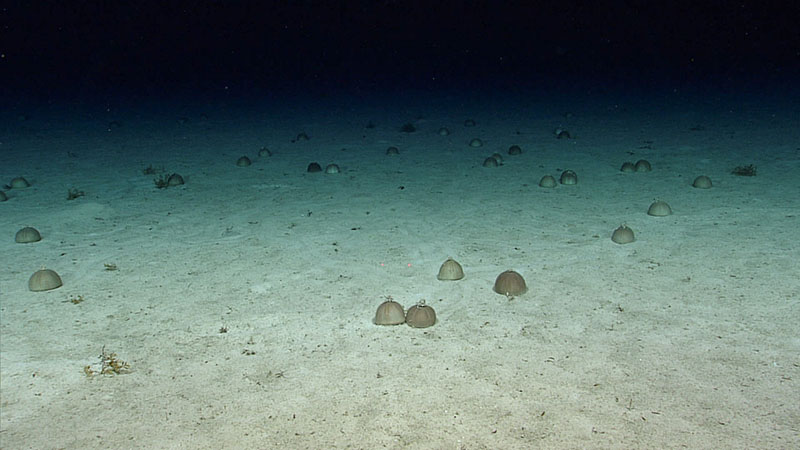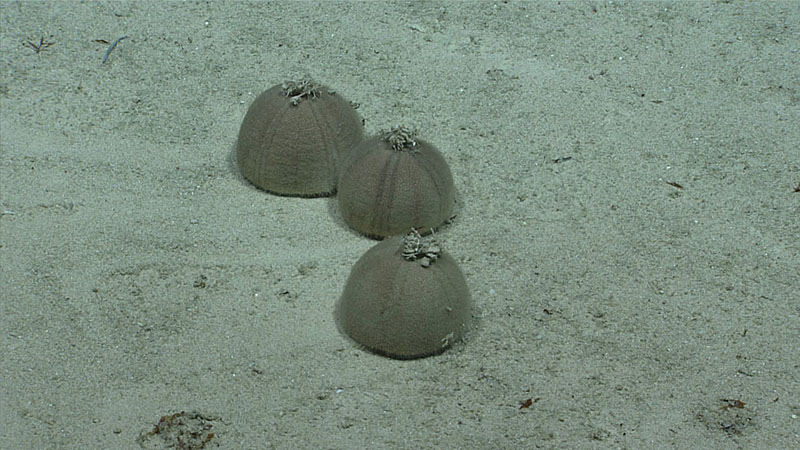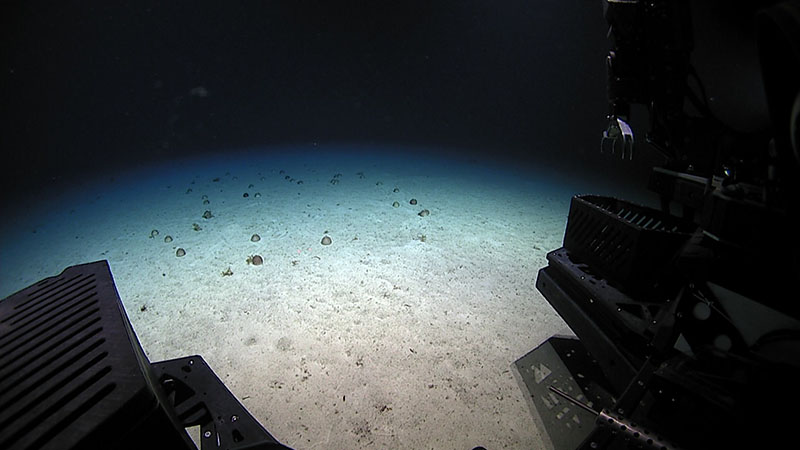Voyage to the Ridge 2022
May 14 - September 2, 2022
A Rarely Seen Sea Urchin Aggregation
During Dive 08 of the third expedition of Voyage to the Ridge 2022, remotely operated vehicle (ROV) Deep Discoverer (D2) was operating in deep waters near St. Croix when it recorded a rarely seen event — a large gathering of the sea urchin Conolampas sigsbei! At a depth of 411 or so meters (1,348 feet), pilots operating the ROV, along with scientists participating in the dive from both sea and shore, and members of the public joining the livestream, encountered a HUGE “crowd” of more than 35 individual Conolampas sigsbei on the seafloor, in what was most likely a mating aggregation!
Urchins reproduce via spawning, which entails emitting their sperm and eggs into the water and allowing the gametes to fertilize in the water column. There is generally no direct contact between the male and female urchins. However, in order to enhance the chances of fertilization, many species of urchins gather in groups, likely for sustained periods of time. Based on our observations, this aggregation included at least 35 individuals spread out over a distance of several meters.
Conolampas is a bit unusual for sea urchins. If one imagines an hemisphere-shaped animal that resembles a steamed bun plowing through the sand of the deep, that’s pretty much what Conolampas looks like! Conolampas belongs to a group known as the “irregular” urchins and has spines which are almost hair-like, much shorter than the shallow-water urchins with which one might be familiar.


This species lives on sandy bottoms in the Bahamian region at a depth of approximately 277-540 meters (909-1,772 feet). These animals live by digging and plowing through sand and sediment, leaving very distinctive, meandering trails behind them. The presence of MANY of these trails in the sand evidenced the movement of this group over the area!
Perhaps the most unusual aspect of this urchin social “meet n’ greet” is the fact that all of the observed urchins displayed some kind of debris on the apex of its body — a sort of ocean debris “hat”!! This seems to be a result of “collecting,” an unusual behavior among urchins which involves gathering and collecting debris, including rocks, shells, and other materials, and bringing them up to a specific place on the animal’s surface — in this case, specifically on the top of the body, reminiscent of a hat.

This urchin “meet n’ greet” was a singular and rarely seen event. There have been observations of shallow-water urchins aggregating to spawn, but for urchins which live at 411 meters depth, well below sunlit waters? This was observation of behavior previously limited to the domain of a very small number of scientists during an age when video was not as high quality, convenient, or dependable as it is today.
This event begs many questions! Do the urchins stay together after spawning is over? How long does the urchin group stay together? Are the urchins actually there for spawning? Is food also a factor? Do the movement tracks in the sand show any deliberate patterns?? And perhaps most interestingly… WHAT IS the deal with those little debris “hats” and why are all the urchins wearing them???


References
Pawson, D.L. & Pawson, D.J. (2013). Bathyal sea urchins of the Bahamas, with notes on covering behavior in deep sea echinoids (Echinodermata: Echinoidea). Deep Sea Research Part II: Topical Studies in Oceanography, Volume 92, pages 207-213.
https://www.sciencedirect.com/science/article/pii/S0967064513000428
Young, C., Eckelbarger, K. J., & Eckelbarger, K. (1994). Reproduction, Larval Biology, and Recruitment of the Deep-sea Benthos. Columbia University Press.
By Chris Mah, National Museum of Natural History
Published September 1, 2022